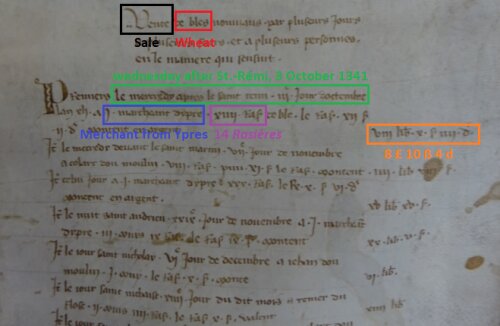Research outline
Central in this project are the late medieval food crises in an urban environment. For an urban environment, the focus is on five cities in and near the Flemish county. To get a better understanding of these food crises we need to analyse the grain prices on the one hand and how large landowners, as big players on the late medieval grain market, dealt with all their income in grain on the other hand.
In order to construct new and exciting grain price series for the 14th century in Flanders, countless grain transactions were gathered from the source material and clustered in a first database. Wheat and oats are the main grain types that were traded. From all these transactions, different types of prices can be distilled: sales, purchases, rents that were converted into species, estimated values of agricultural production etc. For the five cities that were studied, more than 5000 transactions are found for the period of the 14th century. For each transaction, as much information as possible is included: type of transaction, grain type, grain quality, seller, buyer, date, place, quantity, type of coinage, sum of cash that was paid etc.

The image above shows the paragraph for the sales of wheat by the hospital Saint-Sauveur in Lille for the accounting year 1341-1342. The different types of information that can be gathered from this sources is highlighted in several colours. Source image: Lille, Archives Départementales du Nord, Archives Hospitalières VI E 7 n° 13, 1341-1342.
From this treasure of information, different price and grain types can be compared with each other over the 14th century, but also for the different cities and even between the large landowners within the same city. Next to that, the chronology of the prices, on the long and on the short term, is of great importance. On a long term, the regional character of the grain market should become clear (how strong is the market integration?). On the short term, we can use the dated grain transactions to pinpoint the exact start and end of a death period of high prices. Which part of the urban population had to suffer for how long?
A next step is contextualising these prices. Which events could have caused the grain prices to fluctuate up- or downwards? When and where did these events take place? The meteorological circumstances are the most important concerning the quality of the harvest. Extreme weather (too cold or too hot, too wet or too dry) were disastrous for the harvest. Apart from weather, war campaigns could also hamper the yields of grain harvests, e.g. by armies that marching through areas used for agriculture. Apart from that, trade relations were cut off between various regions and embargos were enforced. Epidemics such as the Black Death outbreak (1348) and its following plague pandemics, could also have had a catastrophic impact, especially if this coincided with harvest failures. Important are how the price was influenced by all these different events and the various reactions to this price evolution, both chronologically and geographically.
By confronting these price series with wage levels through the 14th century (data from the project of Sam Geens (UA), supplemented with wages from the accounts used in this project) we can construct the evolution of the real wage through this period. This shows the living standards of the late medieval Flemish urban population, but especially when they got into trouble concerning their food supply. The more detailed the price series, the more precise we can identify the dearth periods.
Apart from the bulk of data that was gathered for the construction of new grain price series, the same accounts also provide detailed information regarding the grain economy of the large landowners. In what manner these large landowners gathered a huge amount of grains in kind and what they did with it is included in a second database consisting of the various streams of income and expenses in kind. A first analysis that can be made with this data is the organisation of the agriculture in the northern-French area. For Inner- and Coastal Flanders, this has already been done. What crops were important and how high was their productivity? How was the harvest organised? What decisions were made regarding the crop choice in relation to the price or income of different crops?
In the context of the various socio-agro systems, the grain economy of the large landowners can be studied. Although, this is not possible for every landlord for which we got prices: enough accounts need to be at hand to systematically analyse the entire 14th century, or at least a large part of it. Adaptions could have occurred in four different domains. First of all, the production of crops could have been altered (crop type, amount of crops…). Secondly, the consumption level of the crops by the landowner could have adjusted over time. Thirdly, the commercialisation side could have changed (the amount that was sold). Lastly, the relationship with the leaseholders is important. As a surplus-extractor, the landowners needed to maintain a profitable relationship with their leaseholders. Looking at how they dealt with debts and arrears can shed light on this question.
These combined research questions will allow us to analyse the food crises of the 14th century more in depth. On the one hand, the shocks caused by different factors can be identified more precisely, both in time and place. On the other hand, we can look at the grain economy of the large landowners in this period in this region and how they coped with these crises: did they mitigate or rather co-produce it?